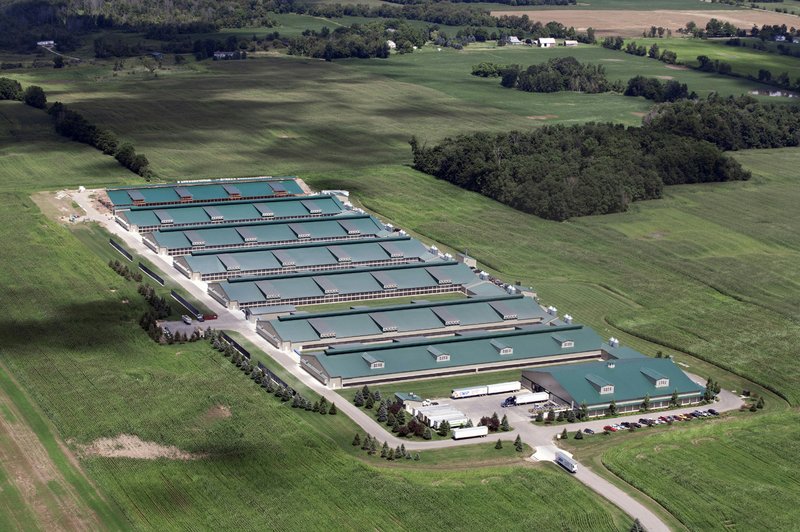SARANAC, Mich. -- Of all the cartons of organic eggs sold in the United States, more than 1 in 10 originates from a complex that houses more than 1.6 million hens.
They're sold under the Eggland's Best label.
"The entire process is organic," Greg Herbruck, president of Herbruck's Poultry Ranch says in a promotional video.
Details of the operation are not publicly available, however, and he declined a Washington Post reporter's request for a visit, citing the possibility that it could infect the flock with disease, such as avian flu.
But according to people familiar with the operation, as well as a building plan, each of the nine long rectangular barns at Herbruck's holds about 180,000 birds, or more than three hens per square foot of floor space, according to sources, who spoke on the condition of anonymity because they had not been authorized to speak for the company.
None of the birds ever set foot outside, sources said.
Under USDA requirements, organic livestock are supposed to have access to the "outdoors," get "direct sunlight" and "fresh air." The rules prohibit "continuous total confinement of any animal indoors." Organic livestock are supposed to be able to engage in their "natural behavior," and for chickens, that means foraging on the ground for food, dust-bathing and even short flights.
Katherine Paul of the Organic Consumers Association said the Herbruck's operation betrays consumer expectations.
"This is not at all what consumers expect of an organic farm," she said, when told about Herbruck's. "It's damaging to the image of the entire industry. People will wonder, 'Why the hell am I paying more for this?'"
In addition, Paul said, allowing the large egg operations to confine their hens to the barn creates an unfair advantage when hundreds of smaller family organic operations let the hens out and sustain higher costs.
The USDA allows Herbruck's and other large operations to sell their eggs as organic because officials have interpreted the word "outdoors" in such a way that farms that confine their hens to barns but add "porches" are deemed eligible for the valuable "USDA Organic" label. The porches are typically walled-in areas with a roof, hard floors and screening on one side.
As for how densely organic livestock may live, the USDA rules do not set an explicit minimum of space per bird, although the regulations do say henhouses should accommodate the "natural behavior" of the animals.
To make more space inside the Herbruck's organic henhouses, which contain 56,000 square feet and stand about 20 feet in height, Herbruck has installed four levels of metal shelves. The shelves are known as "aviaries."
Herbruck said it is misleading to say the hens are kept at three per square foot of floor space because the shelves add space for the birds. He declined to say how much space those shelves provide. He did not dispute the Post's reporting on the number of hens and size of the barns.
And like other large organic egg producers that use porches, Herbruck said the hens are confined to the barns and the porches for their own good.
"The use of organic porches reflects Herbruck's commitment to the hen health and food safety that our customers and consumers demand," Herbruck said in a statement. "Porches keep the hens safe, allowing them to be outdoors while protecting them from wild birds like ducks and geese, and predators like vermin that spread disease and can hurt or kill hens."
Although regulations for animal welfare can mean higher food prices and are sometimes dismissed as a contemporary fad of the elite, Americans -- going back as far as the Puritans -- have looked askance at practices they consider cruel. In 1641, a legal code in Massachusetts banned "any Tirrany or Crueltie toward any bruite Creature which are usuallie kept for man's use."
More recently, U.S. consumers have taken a particular interest in chickens. Seeking to accommodate consumer preferences, large companies such as McDonalds, Subway, Wal-Mart and Starbucks have announced that they will shift to cage-free products.
Voters, too, have shown a willingness to reform chicken operations by effectively banning cages. In 2008, California voters approved stricter rules for confinement at laying hen operations; in 2016, Massachusetts did the same.
Similar concerns for animal welfare have spurred the demand for organic eggs, which are supposed to come from birds that are not only cage-free but also allowed outside. About 12 percent of grocery store expenditures for eggs goes toward those labeled USDA Organic, and many buyers appear to think the hens are allowed out.
More than 80 percent of consumers who regularly buy organic products believe it is important that organic eggs come from chickens that are allowed outside, according to a 2016 survey by Consumer Reports. The Cornucopia Institute, a watchdog group that has sought to guard against weakening of organic standards, has complained repeatedly to the USDA about operations that keep their hens inside.
But exactly what the USDA Organic label signifies on a carton of eggs has become unclear.
The vast majority of small "organic" egg farms in the United States do allow their hens outside. For example, all the farms that produce eggs for the Pete and Gerry's brand are required to let their hens out.
"We think that's what consumers expect of organic eggs," said Jesse Laflamme, co-owner and chief executive at Pete and Gerry's Organics.
Business on 07/14/2017
